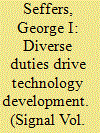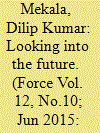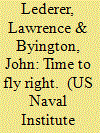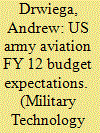| Srl | Item |
| 1 |
ID:
173811


|
|
|
|
|
| Summary/Abstract |
Drones are considered poor coercion tools: They cannot operate in contested airspace and they offer low-cost fights instead of more credible, costly signals. However, this article finds that technological advances will soon enable drones to function in hostile environments. Moreover, drones offer three unique coercion advantages that theorists did not foresee: sustainability in long duration conflicts, certainty of precision punishment which can change the psychology of adversaries, and changes in the relative costs of war. A unique survey of 259 foreign military officers finds that costly signals are less credible than assumed and that drones demonstrate resolve in new ways.
|
|
|
|
|
|
|
|
|
|
|
|
|
|
|
|
| 2 |
ID:
130254


|
|
|
| 3 |
ID:
138644


|
|
|
|
|
| Summary/Abstract |
Unmanned combat air system (UCAS) and unmanned aerial system (UAS) on an aircraft carrier is a considerably new area in naval warfare. It hasn’t been attempted before and owing to the complexity of such a task, it will take a long time before the naval force is able to successfully integrate it into a Carrier Battle Group (CBG). “It is hard to say why this is the case but one likely reason is the considerable complexity around manned carrier operations. Introducing UCAS/UAS into this mix, particularly when the technology for reliable launch and recovery operations on carriers has only recently been proven with the US Navy’s Unmanned Carrier-Launched Airborne Surveillance and Strike (UCLASS) programme, has been perceived as too high a risk at this point,” said Andrew Duggan, managing director, Insitu Pacific Limited. Duggan was speaking at Naval Aviation Seminar in New Delhi, organised by the Indian Navy to take a futuristic look at the field of naval aviation.
|
|
|
|
|
|
|
|
|
|
|
|
|
|
|
|
| 4 |
ID:
135265


|
|
|
|
|
| Summary/Abstract |
The authors look at the medical side of people operating remotely piloted vehicle system (RPVS) and set out criteria against which unmanned aerial vehicle operators’ psychological and physiological qualities must be measured and ways to improve medical supporting services given to them.
|
|
|
|
|
|
|
|
|
|
|
|
|
|
|
|
| 5 |
ID:
130350


|
|
|
| 6 |
ID:
109264


|
|
|